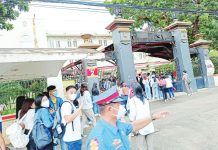
ROME – Archaeologists in the ancient city of Pompeii have discovered a remarkably well-preserved skeleton during excavations of a tomb that also shed light on the cultural life of the city before it was destroyed by a volcanic eruption in AD 79.
A skull bearing tufts of white hair and part of an ear, as well as bones and fabric fragments, were found in the tomb in the necropolis of Porta Sarno, in the east of Pompeii’s urban center.
An inscription of the tomb suggested that its owner, a freed slave named Marcus Venerius Secundio, helped organize performances in Greek in Pompeii. Experts said it was the first confirmation that Greek, the language of culture in the Mediterranean, was used alongside Latin.
The eruption of Mount Vesuvius in 79 AD destroyed Pompeii. Excavations over the years have yielded remarkable discoveries of tombs, chariots, and brilliantly frescoed homes.(AP)







